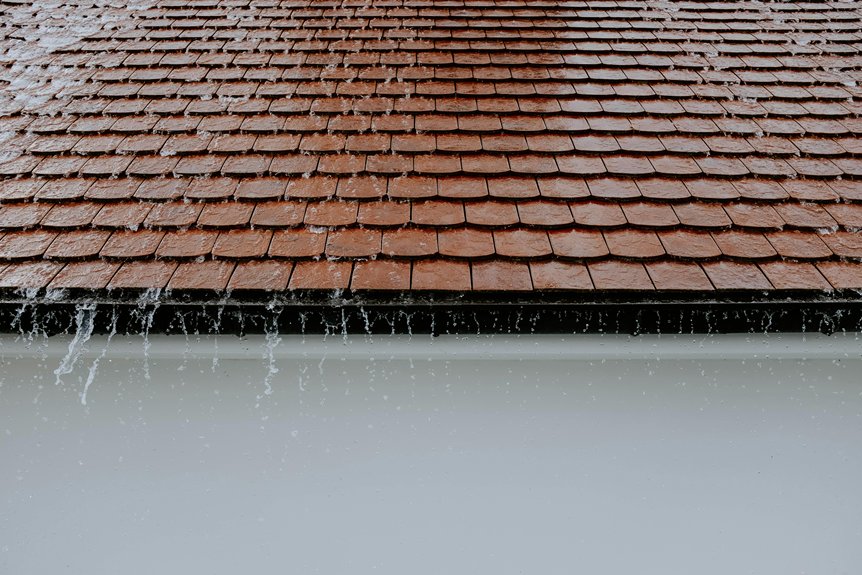Preparing your commercial roof for Texas storm season requires a systematic approach to minimize potential damage and guarantee safety. You need to conduct thorough inspections, identify existing vulnerabilities, and implement targeted repairs before heavy rains and high winds arrive. Proper maintenance of drainage systems and reinforcement of vulnerable areas are essential steps that can make the difference between sustained damage and resilience. To navigate this process effectively, understanding each vital component is indispensable—so, let’s examine where to begin.
Conduct a Thorough Roof Inspection
Before storm season begins, it’s essential to perform a thorough roof inspection to identify vulnerabilities that could lead to damage. Begin by examining the roofing membrane for tears, punctures, or blisters that compromise waterproofing integrity.
Check all flashing around vents, chimneys, and skylights for corrosion, separation, or loose fasteners. Inspect drains, gutters, and downspouts for blockages or debris that hinder drainage.
Assess the condition of roof penetrations and seams for signs of wear or deterioration. Use a ladder and safety harness to access all areas safely.
Document any issues with photographs and detailed notes, ensuring you have an extensive understanding of your roof’s current condition.
Additionally, contacting a professional roofing company like Top View Roofing can help ensure a comprehensive assessment of your roof damage and provide expert recommendations for repairs or maintenance.
Address and Repair Existing Damage
Once you’ve completed your roof inspection and identified areas of deterioration or damage, the next step is to address these issues promptly. Carefully assess the severity of each problem, such as cracks, blisters, or membrane punctures, and determine if repairs can be performed in-house or require a professional roofer.
Use appropriate materials—like sealants, patches, or replacement panels—to ensure a watertight seal. Remove debris and clean damaged areas thoroughly before applying repairs. Document all repairs for future reference and inspections.
Addressing damage quickly prevents leaks, structural deterioration, and costly water intrusion during storms, maintaining your roof’s integrity and extending its lifespan.
Clear and Maintain Drainage Systems
Effective drainage system maintenance is essential to prevent water accumulation that can lead to leaks, structural damage, and reduced roof lifespan. Regularly inspect gutters, downspouts, and scuppers for debris, obstructions, or corrosion.
Remove leaves, dirt, and other debris promptly to guarantee unimpeded water flow. Confirm all components are securely fastened and free of damage, such as cracks or rust.
Verify that slopes and drainage pathways remain effective, correcting any misalignments. Implement a scheduled cleaning routine, especially before storm season, to maintain peak performance.
Proper drainage management minimizes standing water, reducing the risk of ponding and water infiltration during heavy rains.
Reinforce Vulnerable Areas and Seals
After confirming your drainage systems are clear and functioning properly, it’s crucial to focus on reinforcing vulnerable areas and seals to prevent water ingress during storms.
Inspect all roof penetrations, seams, and flashings for deterioration, cracks, or gaps. Apply high-quality, compatible sealants to seal joints and seams securely, avoiding voids.
Reinforce weak points with metal flashings or membrane patches, ensuring tight adhesion. Check for any compromised areas around HVAC units, vents, or skylights, and reinforce these with additional sealing and flashing.
Regularly maintaining and upgrading these vulnerable zones minimizes leaks, enhances durability, and ensures your roof remains resilient during severe weather events.
Develop a Storm Readiness and Emergency Plan
To guarantee your commercial property is prepared for Texas storm season, you must develop a thorough storm readiness and emergency plan that clearly delineates procedures, roles, and communication protocols.
This plan should include specific steps for securing roofing components, such as reinforcing seals and inspecting drainage systems.
Assign responsibilities to staff for monitoring weather alerts, conducting pre-storm inspections, and executing protective measures.
Establish communication channels with emergency services, contractors, and tenants to ensure rapid response.
Regularly review and update the plan based on recent storm data and inspection findings.
This systematic approach minimizes damage risks and enhances your property’s resilience during severe weather events.
Conclusion
To ensure your commercial roof is ready for Texas storm season, it’s important to systematically inspect, repair, and maintain it. Reinforcing vulnerable areas, clearing drainage systems, and establishing a comprehensive storm response plan can significantly reduce potential damages and minimize business downtime. Regular upkeep and proactive measures help maintain roof integrity during heavy rains, high winds, and hail. Staying vigilant and prepared not only protects your investment but also keeps your business operational throughout the storm season. For more information on how to schedule your free roof inspection, call us at (405) 543-2920 or visit us online at Top View Roofing.

